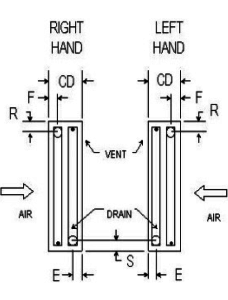Are your chilled water coils right hand or left hand? Are you looking into the face of the coil with the air hitting you in the back of the head? What exactly is counter-flow and why is it important? Are you completely confused by why right hand vs. left hand even exists? Most manufacturers probably do not know or understand the technical reasons themselves.
First, let’s figure out what coils even need a hand determination. Chilled Water Coils, Direct Expansion (Evaporator) Coils, and Condenser Coils are the only coils that need this figured on almost every job. Hot Water Coils, Booster Coils, and Steam Coils rarely need this determination! The reason for this is when the coils are only 1 or 2 rows deep, they can be flipped over. When a chilled water coil is 3+ rows deep, hand determination is much more important because it needs to be counter-flow. With most suppliers determining hand designation with the air hitting you in the back of the head….do you want the connections on the right or left?
 You’ve probably heard the term “counter-flow” countless times, but here’s the simplest explanation. For peak performance, you want the air and the fluid traveling in opposite directions through the coil. Is it the end of the world if your coils are not counter-flow? The short answer is no, but you will lose approximately 5% of the output. So if your coils are piped incorrectly, don’t expect to get the full performance, but they will still be more effective than whatever you’re replacing. Steam and hot water coils are 1 or 2 rows deep, so again, counter-flow is pretty much irrelevant. However, it can make a difference with any chilled water or direct expansion coils (3-12) rows deep.
You’ve probably heard the term “counter-flow” countless times, but here’s the simplest explanation. For peak performance, you want the air and the fluid traveling in opposite directions through the coil. Is it the end of the world if your coils are not counter-flow? The short answer is no, but you will lose approximately 5% of the output. So if your coils are piped incorrectly, don’t expect to get the full performance, but they will still be more effective than whatever you’re replacing. Steam and hot water coils are 1 or 2 rows deep, so again, counter-flow is pretty much irrelevant. However, it can make a difference with any chilled water or direct expansion coils (3-12) rows deep.
We also get asked many times “what is the proper way to pipe coils?” Put simply, steam coils should always be fed on the highest connection and the return on the lowest connection. Water coils should always be fed on the lowest connection and returned on the top connection to ensure that all of the tubes are are fed the same volume of fluid.
Hand designation and counter-flow are two pretty simple concepts when they are properly explained. When dealing with a HVAC coil manufacturer, partner up with one who will walk you through the engineering and explain it along the way. Capital Coil & Air has well over a decade of experience in handling pretty much any scenario that you may come across, so we want to be your coil resource for any and all projects. Please give us a try on your next job!
RELATED POSTS
Why are HVAC Coils Copper Tube and Aluminum Fin?
Did You Know? Facts about Commercial HVAC Coils
You should never have to worry about performance on replacement coils…Well, almost never!
